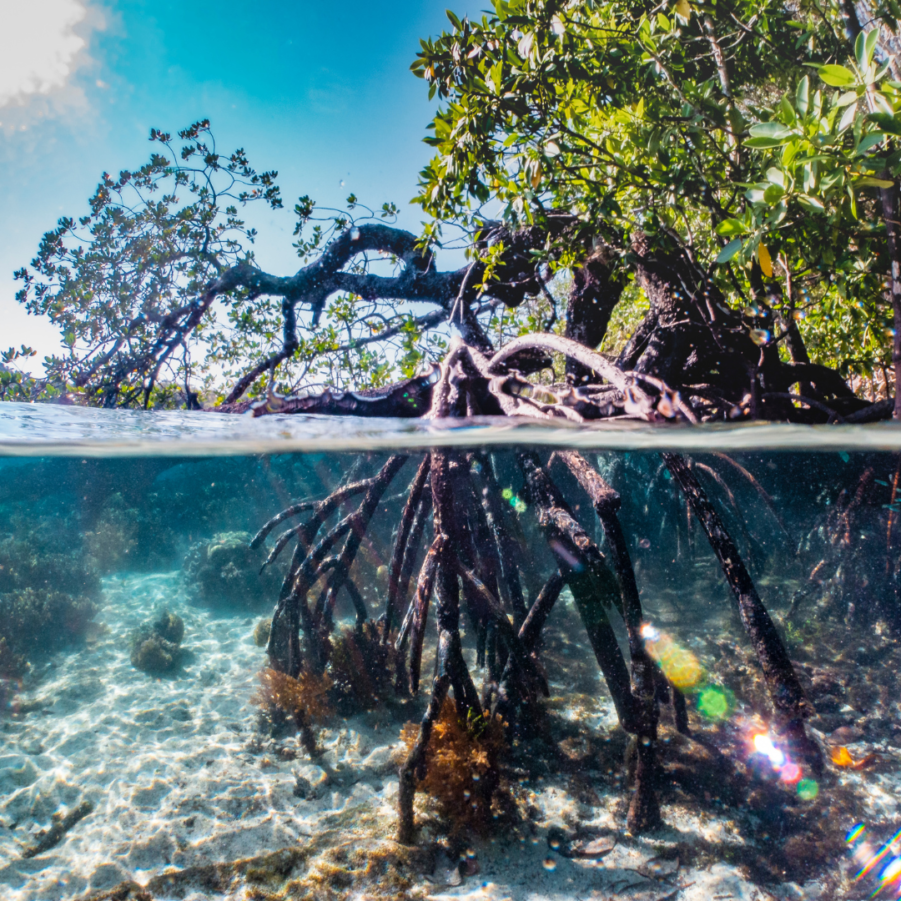Mangroves are some of the world’s most famous plants. Among their many claims to fame, they are uniquely capable of growing in salt water, and are credited with saving thousands of human lives every year. In this Wildlife Spotlight post, let’s get to know these amazing plants and what makes them so fascinating.
One name, many species
The name “mangrove” actually refers to many different tree and shrub species that are capable of living and growing in salt water. In fact, there are over 70 species of mangrove worldwide, belonging to a whopping 16 different families. In other words, many of the mangrove species are completely unrelated to one another. This is a similar problem to daddy long-legs, which is a common name for several different animals.

Why do species have scientific names?
Two widespread mangrove species are the red mangrove Rhizophora mangle and black mangrove Avicennia germinans. These two species are common in the Caribbean, as well as the tropical coasts of South and Central America. Other species include:
- White mangrove (Laguncularia racemosa), found in Central America and Africa
- Large-leafed mangrove (Bruguiera gymnorhiza), in coasts throughout the Western Pacific and Indian Ocean, as well as Southern Africa
- Yellow mangrove (Ceriops australis), occurring in Northern (tropical) Australia
- Grey mangrove (Avicennia marina), ranging from Eastern Africa to Southeast Asia and Australia
- Sonneratia alba, native to subtropical India, Pakistan and Bangladesh, southern China, Malaysia, Indonesia, and parts of Australia
Wondering what’s the difference between species, genera, and families? Check out my Beginner’s guide to taxonomy!
Where can you find mangroves?
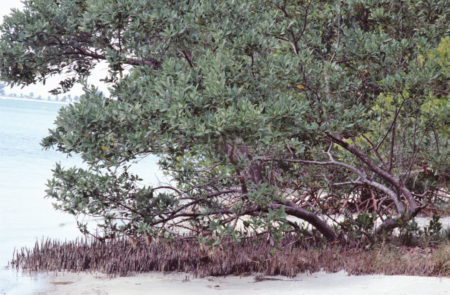
As this list of species shows, these neat plants are found in coastal areas all over the world. They grow in shallow, salty water, in estuaries, coves, bays, and other stretches of shoreline. Because of their special adaptations to salt water, mangroves have little competition for space from other species. One major factor seems to limit where you can find mangroves: temperature. These tropical and subtropical plants only show up in places where water temperature doesn’t go below 73°F (23°C)!
If you live in a temperate area like Southern New Zealand, North America, or Europe and haven’t seen mangroves before this might be why! Mangroves have even been introduced to tropical places where they did not historically occur. For example, they are now considered an invasive species in Hawai’i, despite having having protected and endangered status elsewhere in the United States!
Why are invasive species a problem?
What makes mangroves special?
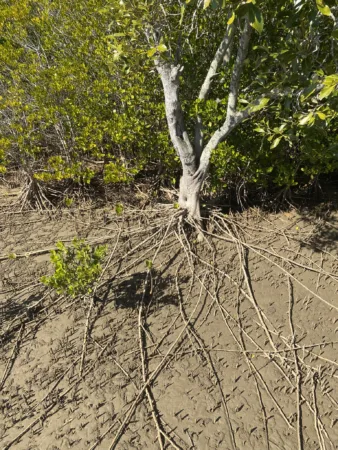
Salt life
If you’ve got a green thumb, you may be familiar with the fact that exposure to salt is typically fatal for plants. So you might ask, how do mangroves survive in salt water? Different mangrove species have developed different strategies for dealing with all that extra salt. For example, trees in the genus Rhizophora actually have powerful biological filters in their roots which exclude salt as they take in water. By contrast, Avicennia species and several others expel salt through their leaves, where it accumulates in little crystals.
Breathing underwater
Plants, just like animals, need to “breathe”, that is, respire, to carry out their vital functions. Mangroves are no exception. However, their coastal lifestyle, often embedded in waterlogged poses some problems for breathing. This is an even bigger problem considering how, given the tides, most mangroves are flooded multiple times per day. As you might have guessed, different species of mangroves have solved this problem in different ways.
In all cases, the plants rely on special pores on their roots called lenticels which can open up and take in air. Rhizophora mangroves have a high concentration of these along their raised prop-roots, which spend more time above water and also hold the plants upright despite the mushy soil in which they’re anchored. Avicennia and other species use small vertical roots called pneumatophores which pop up above the soil. These can be thin and cylindrical like a spike, or cone-shaped. Both of these modified root types act in some ways like a snorkel, allowing the plant to exchange gases with the atmosphere, or “breathe” even when flooded.
Sea-faring babies

One of the weirdest facts about mangroves is that most species reproduce by growing young plants on their outer branches, rather than producing seeds. You might say that they “give live birth”, like sharks! If you visit a mangal at the right time of year, you might see adorable, live baby plants growing off of their parent tree. After they complete development, these little sprouts will fall off and drift in the surrounding ocean currents. This allows the baby mangroves a chance to strike out on their own and find a place to live where they won’t be crowded out by their parents.
How long do these sea-faring seedlings spend at sea? Unfortunately, it’s not up to them! They are at the mercy of the waves and currents, and many probably do not survive. Most mangrove species’ young can survive several days to several weeks at sea before becoming waterlogged. However, scientists have reported Rhizophora sprouts germinating after over a year!
How do wild plants get their seeds into suitable growing spots?
Mangroves as habitat
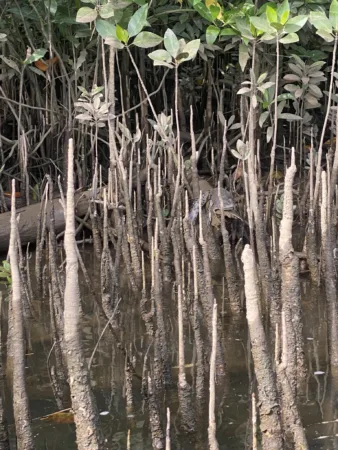
Mangrove forests, also known as mangal, provide excellent habitat for a variety of animals. These include specialized species like tree-climbing mangrove crabs (Aratus pisonii), and insect species adapted to feed on mangrove leaves. Amazingly, some tigers in the Sundarban wetlands of the Indian subcontinent live and hunt in mangroves! A variety of birds, bats, and reptiles also make use of mangroves. Meanwhile, when mangroves are flooded by salt water, they act as fantastic nurseries for young fish hoping to stay clear of predators.
Read more: 18 awesome facts about tigers
The critical importance of mangroves in creating coastal habitats that support abundant biodiversity makes them keystone species. In other words, like coral reefs, they have an especially large impact on their local environment. Another name that describes mangroves very well is ecosystem engineers, since they change coastlines and create habitat for other plants and animals. This makes mangroves a critical part of coastal ecosystems in many parts of the world. Without them, many other species would be lost!
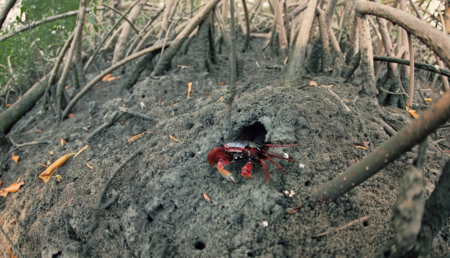
Want to learn more about red mangroves and their amazing natural history? Check out this great episode of the Nature Guys Podcast below!
Mangroves protect coastlines

Tigers and crabs aren’t the only animals that benefit from mangroves. They actually provide fantastic services to people, too! By stabilizing coastal soils and providing a “living seawall” that can break up and withstand waves, mangroves protect coastlines from damaging waves during storms. In some cases, beach houses and other coastal properties in parts of Florida and the Caribbean have been shielded by the worst of severe storm events because mangroves were growing nearby. Because they can regrow quickly after such an event, mangroves may be a more durable and inexpensive way to protect tropical coastlines than concrete, man-made structures!
Thanks for reading about mangroves!
Would you like to see another species highlighted on Gulo in Nature? Drop us a line using the Contact page. If you enjoyed this post and want to support the blog, please share this article with friends via social media.

